Small overlap front: driver-side
Rating applies to 2015-20 models built after February 2015
Tested vehicle: 2015 Chevrolet Sonic LT 4-door
The Chevrolet Sonic was introduced in the 2012 model year. Beginning with 2015 models built after February 2015, the front-end structure, door sill, and hinge pillar were modified to improve occupant protection in small overlap frontal crashes. Also, the side curtain airbags were lengthened and reprogrammed to deploy earlier in small overlap crashes. The small overlap frontal ratings apply to both the 4-door sedan and hatchback (5-door) versions of the Sonic.
| Evaluation criteria | Rating |
|---|---|
| Structure and safety cage | |
| Driver injury measures | |
| Head/neck | |
| Chest | |
| Hip/thigh | |
| Lower leg/foot | |
| Driver restraints and dummy kinematics | |
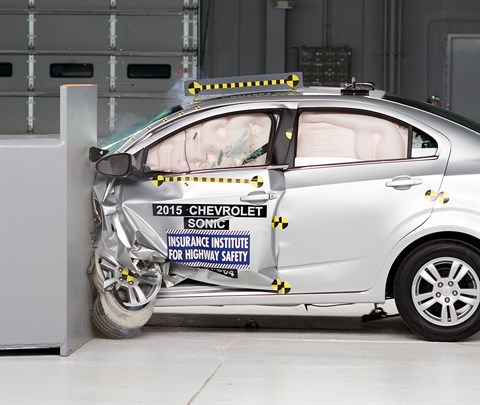
Action shot taken during the small overlap frontal crash test.

The dummy's position in relation to the door frame, steering wheel, and instrument panel after the crash test indicates that the driver's survival space was maintained reasonably well.
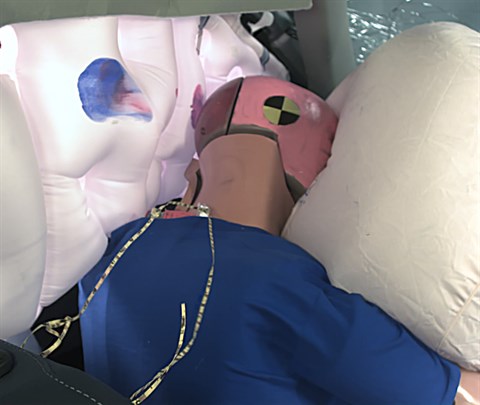
The frontal and side curtain airbags worked well together to keep the head from coming close to any stiff structure or outside objects that could cause injury.

Intrusion into the driver's space was maintained reasonably well, and risk of injuries to the dummy's legs and feet was low.
Rating applies to 2012-15 models built before March 2015
Tested vehicle: 2013 Chevrolet Sonic LT 4-door
The Chevrolet Sonic was introduced in the 2012 model year. The small overlap frontal ratings apply to both the 4-door sedan and hatchback (5-door) versions of the Sonic.
| Evaluation criteria | Rating |
|---|---|
| Structure and safety cage | |
| Driver injury measures | |
| Head/neck | |
| Chest | |
| Hip/thigh | |
| Lower leg/foot | |
|
Driver restraints and dummy kinematics
The dummy’s head barely contacted the frontal airbag before sliding off the left side as the steering column moved to the right, leaving the head vulnerable to contact with forward side structure. Additionally, the seat belt allowed excessive forward excursion of the dummy’s head and torso. The side curtain airbag deployed too late during the crash, after the head had moved to the left and was already rebounding, outboard of the inflating curtain, leaving the dummy's head vulnerable to contact with side structure and outside objects. | |
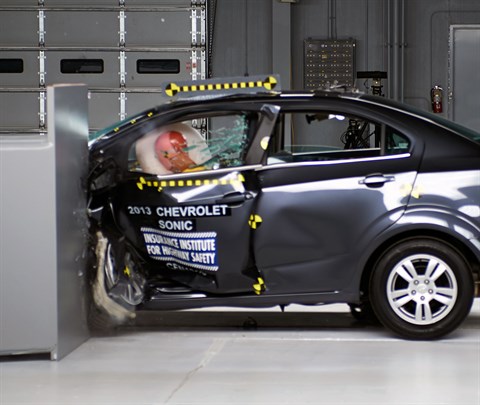
Action shot taken during the small overlap frontal crash test.
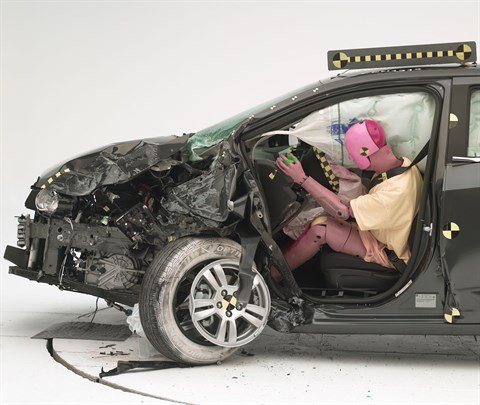
The dummy's position in relation to the door frame, steering wheel, and instrument panel after the crash test indicates that the driver's survival space was maintained reasonably well.
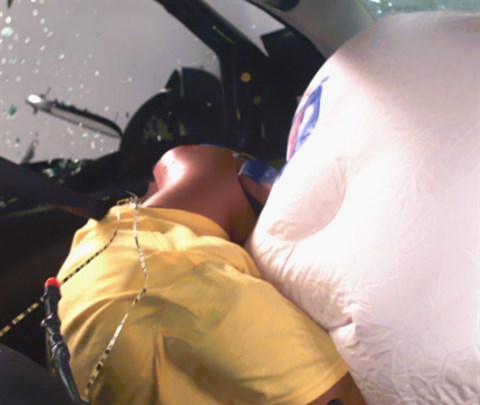
During the crash, the dummy's head barely contacted the frontal airbag before sliding off to the left, and the side curtain airbag deployed too late (after the time shown in the freeze frame) to offer any head protection, leaving the dummy's head exposed to contact with side structure and outside objects. The seat belt allowed the dummy to move too far forward, as is evident from the gap between the seat back and the dummy's torso.
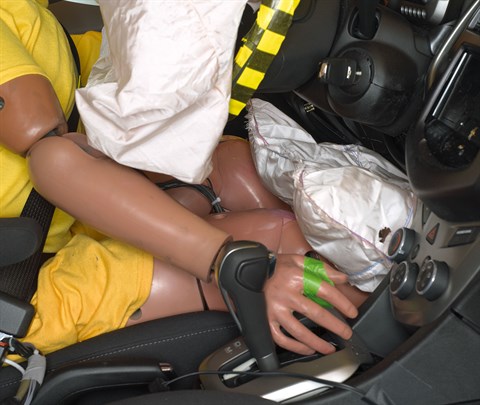
Even though the knee airbag deployed, intrusion of the instrument panel contributed to a significant risk of injury to the right lower leg and a moderate risk to the left knee.
Moderate overlap front: original test
Rating applies to 2012-20 models
Tested vehicle: 2012 Chevrolet Sonic 2LT 4-door
The Chevrolet Sonic was introduced in the 2012 model year as a replacement for the Chevrolet Aveo. The moderate overlap frontal ratings apply to both the 4-door sedan and hatchback (5-door) versions of the Sonic.
| Evaluation criteria | Rating |
|---|---|
| Overall evaluation | |
| Structure and safety cage | |
| Driver injury measures | |
| Head/neck | |
| Chest | |
| Leg/foot, left | |
| Leg/foot, right | |
| Driver restraints and dummy kinematics | |
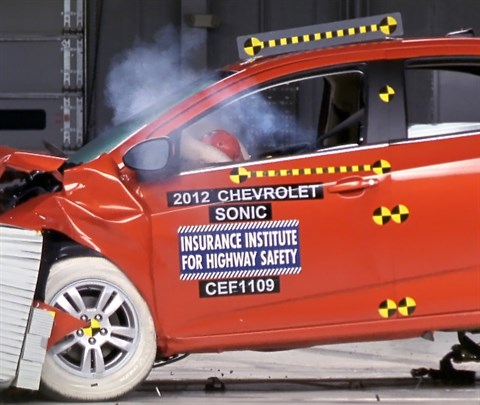
Action shot taken during the frontal offset crash test.

The dummy's position in relation to the steering wheel and instrument panel after the crash test indicates that the driver's survival space was maintained very well.
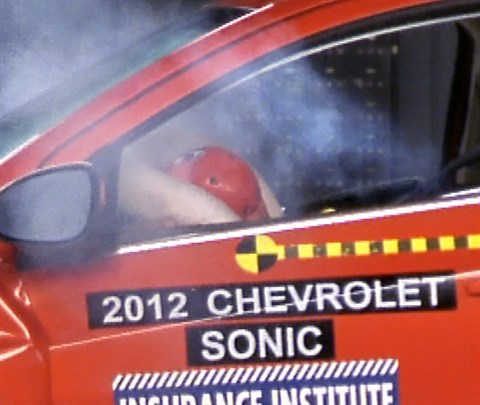
A high head acceleration occurred when the dummy's head hit the steering wheel through the airbag.
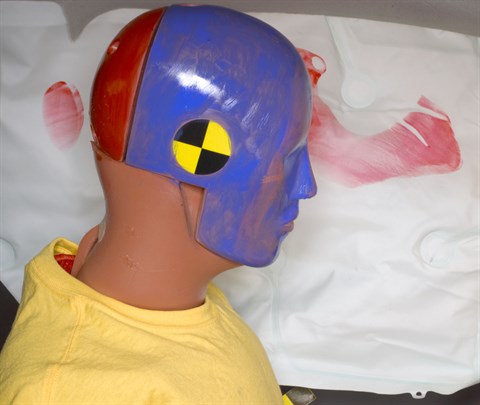
Smeared greasepaint shows where the driver dummy's head was protected from hitting hard structures during rebound by the side curtain airbag.
Side: original test
Rating applies to 2012-20 models
Tested vehicle: 2012 Chevrolet Sonic 2LT 4-door with standard front and rear head curtain airbags and standard front and rear seat-mounted torso airbags
The Chevrolet Sonic was introduced in the 2012 model year as a replacement for the Chevrolet Aveo. The side ratings apply to both the 4-door sedan and hatchback (5-door) versions of the Sonic.
| Evaluation criteria | Rating |
|---|---|
| Overall evaluation | |
| Structure and safety cage | |
| Driver injury measures | |
| Head/neck | |
| Torso | |
| Pelvis/leg | |
| Driver head protection | |
| Rear passenger injury measures | |
| Head/neck | |
| Torso | |
| Pelvis/leg | |
| Rear passenger head protection | |
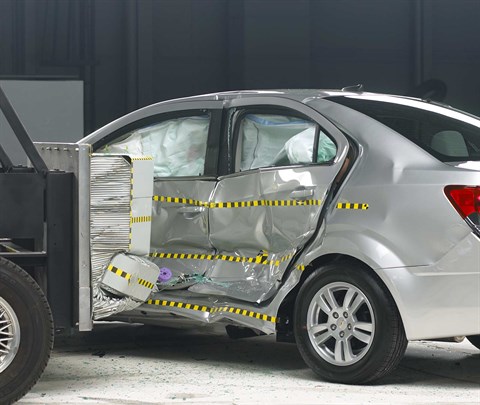
View of the vehicle and barrier just after the crash test.

View of the vehicle after the crash with doors removed, showing the side airbags and damage to the occupant compartment.
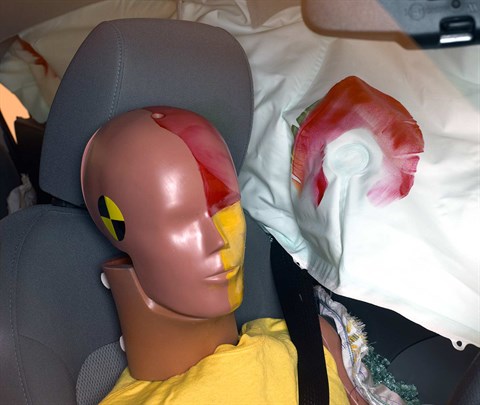
Smeared greasepaint shows where the driver dummy's head was protected from being hit by hard structures by the side curtain airbag.
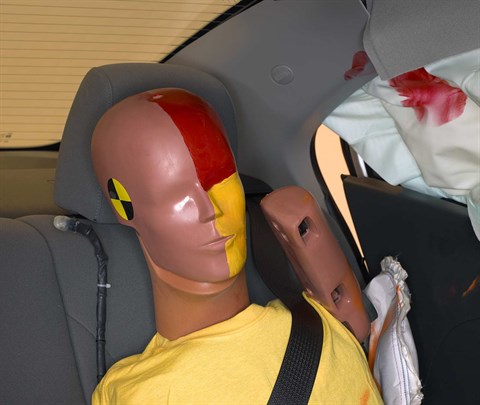
Smeared greasepaint shows where the rear passenger dummy’s head was protected by the side airbag.
Roof strength
Rating applies to 2012-20 models
Tested vehicle: 2012 Chevrolet Sonic 2LT 4-door
Rating also applies to the 4-door hatchback (5-door) version.
| Overall evaluation | |
|---|---|
| Curb weight | 2,787 lbs |
| Peak force | 14,976 lbs |
| Strength-to-weight ratio | 5.37 |
Head restraints & seats
Seat type: Manual cloth seat
| Overall evaluation | |
|---|---|
| Dynamic rating | |
| Seat/head restraint geometry |
About the head restraint & seat test
Currently, IIHS tests apply only to front seats.
Front crash prevention: vehicle-to-vehicle
Child seat anchors
Rating applies to 2015-20 models
| Evaluation criteria | Rating |
|---|---|
| Overall evaluation | |
| Vehicle trim | LT (sedan) |
| Seat type | cloth |
This vehicle has 2 rear seating positions with complete child seat attachment (LATCH) hardware.
It has 1 additional seating position with a tether anchor only.
| Evaluation criteria | Rating |
|---|---|
| Overall evaluation | |
| Vehicle trim | LT (sedan) |
| Seat type | cloth |
| Rating icon | Rating |
|---|---|
| G | Good |
| A | Acceptable |
| M | Marginal |
| P | Poor |
| Seating positions that rely on borrowed lower anchors or have only a tether anchor available are not rated. | |
thether anchor symbol | Tether anchor |
lower anchor symbol | Lower anchors |
| Lower anchor(s) can be borrowed from adjacent positions(s) | |
| No hardware available |
Details by seating position
| Position | Rating |
|---|---|
| 1 | |
| Tether anchor | |
| easy-to-find location | |
| no other hardware could be confused for anchor | |
| Lower anchors | |
| too deep in seat | |
| not too much force needed to attach | |
| difficult to maneuver around anchors | |
| 2 | |
| Tether anchor | |
| easy-to-find location | |
| no other hardware could be confused for anchor | |
| Lower anchors | |
| none available | |
| 3 | |
| Tether anchor | |
| easy-to-find location | |
| no other hardware could be confused for anchor | |
| Lower anchors | |
| too deep in seat | |
| not too much force needed to attach | |
| difficult to maneuver around anchors |
